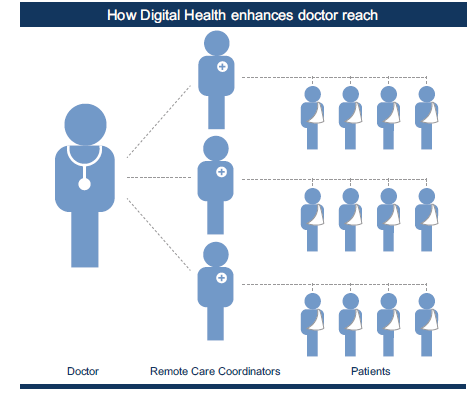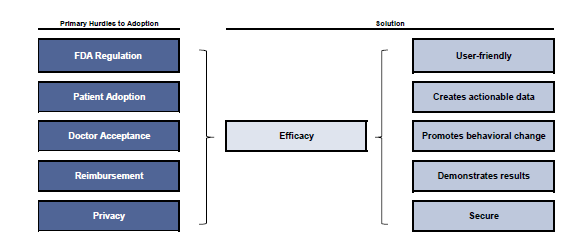It’s 21st century outdoors, and all the innovations are aimed to improve our everyday life and make it easier. We all are going to live better, longer, and more straightforward than the previous generations. Everything that is creating now or was created yesterday or will be created tomorrow has the one goal in common – simplicity. What does this simplicity mean? In this article, we will discuss healthcare, or rather the innovations in the world of medicine. Nowadays the most popular topic of discussions is IoT that has penetrated the healthcare and is going to change everything drastically. Remote patient monitoring, behavioral modification platforms, and telehealth – it all sounds super good but whether it is a breakthrough or will complicate the routine things order?
What do you Promise Us, Healthcare IoT?
The IoT in healthcare has just started its development but is going to revolutionize the whole industry. It can significantly improve the management of chronic diseases and at the same time reduce the costs. Advancement in wireless technology together with a shift to value-based care from fee for service has opened the new horizons for the IoT growth and development. The digital health promises us affordable, efficient, and easily accessible patient solutions. These innovations are going to change the high cost, high tech, and low access to present healthcare for the low cost, high tech, and low access in the nearest future. Based on this, we can make the first assumptions of the digital health’s influence on our life – it is going to improve patient care and, at the same time, reduce waste and costs.
All the digital health technologies we can divide into the three main groups:
- Remote patient monitoring (RPM);
- Telehealth;
- Behavior modification.
According to the clinical standpoint, the chronic disease management is the most crucial issue for today and takes the one-third of the annual US healthcare expenditures. Speaking about the main changes that the world is waiting from the IoT coming (and that can become a reality soon) are:
- “In cloud” hospital. The coming of the mobile era and the noticeable advancement of sensors currently allow the medical equipment to be miniaturized greatly. The digital care technologies have all the chances to create a hospital of the future which will be based “in a cloud.” Even if taking into account that non-network care facilities unlikely will disappear completely, the development of the IoT in the healthcare industry can significantly minimize them and make a big step from the usual restrictive healthcare system to the open and accessible care platform of the future.
- Electronic medical records and integration with smartphones. The current technologies are at the high level that is enough to support digital health adoption. The majority of the currently available technologies are aimed at the health-conscious individuals, not at the chronic disease management or reduce the acute need for acute care hospitals visits. The arrival of the IoT entails the electronic medical records and the full integration with the smartphone technology. With their adoption, wearable and implantable devices can provide the physicians with the actionable data.
- Digital technologies are not only for patients. The ways digital technologies can evolve care are still creating and developing. They are different and are designed not only for patients but for all the stakeholders. Physicians, hospital administrators, and, of course, patients can use the technologies to engage with each other and get the necessary information. For example, for patients, it may be an application for tracking a range of health metrics. At the same time, for the physician, it may be another application allowing to monitor data and modulate the medications prescriptions. Purposes are different, applications are various, but the goal is the same – simplicity. All this is designed to make the healthcare industry simpler for all the parties involved. The one thing that we can state with confidence – the changes that have already been made and that will be made in the future are aimed at the interplay among physician, patient, and healthcare system. It has never been seen in the past and is going to become a breakthrough in the industry. Instead of data collection or information repositories, the new technologies engage the entire community and provide analytical value that is a big step forward.
- Large healthcare companies are already “in-game.” The interest to the digital health technologies and especially to benefits that they can provide is increasing each day. Nowadays, some of the largest healthcare companies have decided to adopt digital health. Such “giants” as Medtronic, Philips, and J&J have already “entered the game” by making partnerships with start-up companies and technology monsters like IBM. In addition to these partnerships, some companies are going to completely change their business model to get the maximal benefits from the digital health technologies adoption.
What is the Healthcare IoT?
Ok, what we have for now? IoT is the most significant innovation in the healthcare industry. It is going to significantly reduce the cost and make the whole process much more straightforward. What else do we know about this mystic “digital health technologies?” Let’s sort out how does the IoT work in the healthcare world.
If trying to find the information about IoT on the Internet, you will be surprised because any object that is capable of transmitting the data to the Internet falls under the “IoT” concept. Our object of interest is healthcare, so cutting the information to the healthcare IoT (or HC IoT) we get the following definition. HC IoT is the set of platforms that create patient data to help with treatment or prevent various diseases outside the traditional care setting. It is not only more convenient for both the physician and patient, but also helps to eliminate costs significantly. It is evident that such a revolution in the healthcare industry can’t happen in one or two years and change everything drastically. Evaluating the speed of IoT development and growth, the expected period of penetration in our everyday life is from five to ten years. For now, we can divide the HC IoT into three broad categories:
- Remote patient diagnostics and monitoring (RPM). The primary goal of this category is to help the physician to keep an eye in the chronically ill or recently released patients. In many cases, people suffering from chronic diseases refer to the older demographic. It means that it may be harder for them to track changes in their health and, in case, if their condition worsens, it may be quite difficult for them to go to the hospital. The RPM devices and applications aimed at the control of the “high-risk” patients and can improve chronic disease management in two ways: a) Interpreting and presenting actual data to the patient, allowing him to understand the current status of their health condition and act if the negative progression has occurred; b) Continuous reading and interpreting the vital signs and alerting medical professionals in case if the acute care event approaches. Among the examples of such devices are glucose monitors that send diabetics’ data to their smartphones, wearable patches diagnosing heart conditions, and sensors that detect poor air quality and monitors the asthma medications intake.
- Telehealth. This category is aimed at getting the doctor’s advice from outside an office visit and helps to reduce costs for the primary physician visits noticeably. It is convenient if you live in another city/country or don’t have time to take the whole family to the doctor’s office to get the prescription for your child. Examples of the telehealth include doctor’s consultation across the country, primary care physician visits, and prescription of medications without leaving home. Therefore, telehealth allows reducing costs, saving money and efforts to get to the doctor’s office. For example, if you have a rash, you can send a photo to dermatologist or video conference a physician instead of going to the hospital.
- Behavior modification. The third category includes platforms the main goals of which is to help patients change their habits and start leading a healthy lifestyle. The primary purpose of all these platforms is preventing illness. For example, it can be a platform for diabetes prevention through smoking cessation and digital weight loss coaching.
Obstacles and Complications
As well as any arising technology, digital health faces the number of difficulties on the way between it and the customer acceptance. Clinical trialing, FDA approval, getting the recognition in the medical community, as well as the conclusion of partnerships with payers, require not only deep-pockets but also immense trade knowledge.
Besides this, lots of industry participants stated that if a therapy works, all the rest will come. It means that if the digital health gives the noticeable results that coincide with promises given, then the FDA, doctors, consumers, and payers will come and enter the game. Efficacy remains the “gold standard” to judge HC IoT. Under the “efficacy” term it is meant that it is the user-friendly platform that collects actionable and accurate patient data, promotes behavioral change, demonstrates the results, and protects sensitive information.
The main benefits of IoT Healthcare worth all the efforts spending. They include:
- More convenience. People with chronic diseases don’t have to regularly visit the doctor;
- Saved time and efforts. People can ask all the questions to the physician remotely;
- Reduced costs. Expenses for transportation to the hospital are reduced due to telehealth;
- Preventing illnesses with the app. Platforms for behavior modification can help to change the lifestyle and prevent possible health problems;
- Immediate transportation of the high-risk patients to the hospital due to remote patient monitoring (RPM).
Anything great was created without obstacles and difficulties, and the way to success has never been easy. We believe that in the nearest future the healthcare industry will change with the digital health technologies and make the treatment process more accessible. The one thing we know for sure, that in five, ten, twenty years, the world will not be the same as now, and the new technologies will change our lives for the better.



Recent Comments